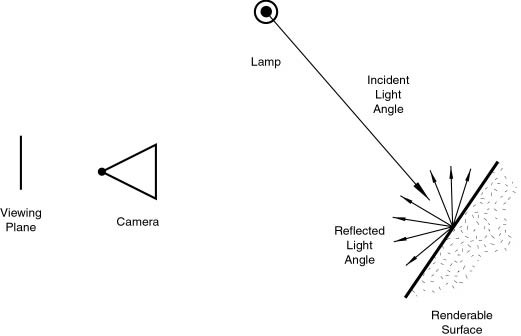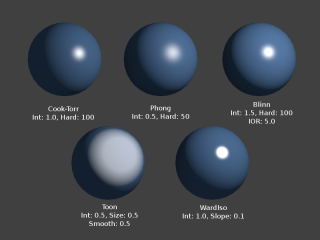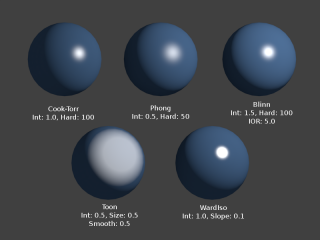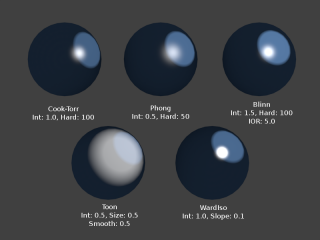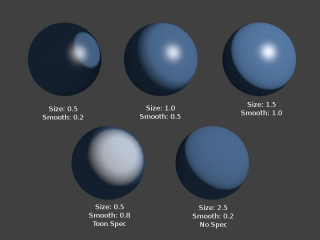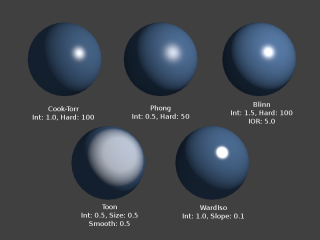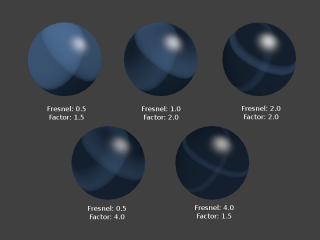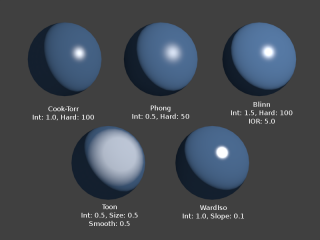利用者:Sculptorjim/Materials/Properties/Diffuse
Diffuse Shaders
Mode: All Modes
Panel: Shading/Material Context → Diffuse
A diffuse shader determines, simply speaking, the general color of a material when light shines on it. Most shaders that are designed to mimic reality give a smooth falloff from bright to dark from the point of the strongest illumination to the shadowed areas, but Blender also has other shaders for various special effects.
Common Options
All diffuse shaders have the following options:
- Color
- Select the base diffuse color of the material
- Intensity
- The shader's brightness, or more accurately, the amount of incident light energy that is actually diffusely reflected towards the camera.
- Ramp
- Allows you to set a range of colors for Material, and define how the range will vary over a surface. See Ramps for details.
Technical Details
Light striking a surface and then re-irradiated via a Diffusion phenomenon will be scattered, i.e., re-irradiated in all directions isotropically. This means that the camera will see the same amount of light from that surface point no matter what the incident viewing angle is. It is this quality that makes diffuse light viewpoint independent. Of course the amount of light that strikes the surface depends on the incident light angle. If most of the light striking a surface is reflected diffusely, the surface will have a matte appearance (Light re-irradiated in the diffusion phenomenon.).
Shader Names
Lambert
Mode: All Modes
Panel: Shading/Material Context → Shaders
This is Blender's default diffuse shader, and is a good general all-around work horse for materials showing low levels of specular reflection.
- Johann Heinrich Lambert (1728-1777)
- was a Swiss mathematician, physicist and astronomer who published works on the reflection of light, most notably the Beer-Lambert Law which formulates the law of light absorption.
This shader has only the default option, determining how much of available light is reflected. Default is 0.8, to allow some other objects to be brighter.
Oren-Nayar
Mode: All Modes
Panel: Shading/Material Context → Shaders
Oren-Nayar takes a somewhat more 'physical' approach to the diffusion phenomena as it takes into account the amount of microscopic roughness of the surface.
- Michael Oren and Shree K. Nayar
- Their reflectance model, developed in the early 1990s, is a generalization of Lambert's law now widely used in computer graphics.
Options
- Roughness
- The roughness of the surface, and hence, the amount of diffuse scattering
Toon
Mode: All Modes
Panel: Shading/Material Context → Shaders
The Toon shader is a very 'un-physical' shader in that it is not meant to fake reality but to produce cartoon cel styled rendering, with clear boundaries between light and shadow and uniformly lit/shadowed regions.
Options
- Size
- The size of the lit area
- Smooth
- The softness of the boundary between lit and shadowed areas
Minnaert
Mode: All Modes
Panel: Shading/Material Context → Shaders
Minnaert works by darkening parts of the standard Lambertian shader, so if Dark is 1 you get exactly the Lambertian result. Higher darkness values will darken the center of an object (where it points towards the viewer). Lower darkness values will lighten the edges of the object, making it look somewhat velvet.
- Marcel Minnaert (1893-1970)
- was a Belgian astronomer interested in the effects of the atmosphere on light and images who in 1954 published a book entitled The Nature of Light and Color in the Open Air.
Options
- Dark
- The darkness of the 'lit' areas (higher) or the darkness of the edges pointing away from the light source (lower).
Fresnel
Mode: All Modes
Panel: Shading/Material Context → Shaders
With a Fresnel Shader the amount of diffuse reflected light depends on the incidence angle, i.e. from the direction of the light source. Areas pointing directly towards the light source appear darker, areas perpendicular to the incoming light become brighter.
- Augustin-Jean Fresnel (1788-1827)
- was a French physicist who contributed significantly to the establishment of the theory of wave optics.
Options
- Fresnel
- Power of the Fresnel effect, 5.0 is max.
- Factor
- Blending factor of the Fresnel factor to blend in, 5.0 is max.
